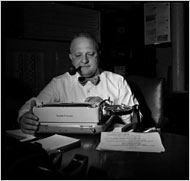 I learned to touch type on a manual typewriter when I was about 10 or 11. I guess that was my first experience with fonts — I didn’t know that then but I remember liking that my typewritten sheets looked neat and tidy, as opposed to my crooked and messy handwritten reports. As a freshman in college, I worked in the computer center, where they had one of the first laser printers. I was envious of the graduate students using it for their papers and even computer program listings — they no longer had just fixed-width Courier at their disposal, they had beautiful Times!
I learned to touch type on a manual typewriter when I was about 10 or 11. I guess that was my first experience with fonts — I didn’t know that then but I remember liking that my typewritten sheets looked neat and tidy, as opposed to my crooked and messy handwritten reports. As a freshman in college, I worked in the computer center, where they had one of the first laser printers. I was envious of the graduate students using it for their papers and even computer program listings — they no longer had just fixed-width Courier at their disposal, they had beautiful Times!
![]() But back to typewriters… I read with interest an obituary in the NY Times the other morning: “Martin K. Tytell, Typewriter Wizard, Dies at 94.” From the obituary:
But back to typewriters… I read with interest an obituary in the NY Times the other morning: “Martin K. Tytell, Typewriter Wizard, Dies at 94.” From the obituary:
Martin Tytell, whose unmatched knowledge of typewriters was a boon to American spies during World War II, a tool for the defense lawyers for Alger Hiss, and a necessity for literary luminaries and perhaps tens of thousands of everyday scriveners who asked him to keep their Royals, Underwoods, Olivettis (and their computer-resistant pride) intact, died on Thursday in the Bronx. He was 94…. He made a hieroglyphics typewriter for a museum curator, and typewriters with musical notes for musicians. He adapted keyboards for amputees and other wounded veterans. He invented a reverse-carriage device that enabled him to work in right-to-left languages like Arabic and Hebrew. An error he made on a Burmese typewriter, inserting a character upside down, became a standard, even in Burma….
Mr. Tytell was proud of the rarity of his expertise, and relished the eccentric nature of his business. “We don’t get normal people here,” he said of his shop. And he was aware that his connection to the typewriter bordered on love.
“I’m 83 years old and I just signed a 10-year lease on this office; I’m an optimist, obviously,” Mr. Tytell told the writer Ian Frazier in a 1997 article in The Atlantic Monthly, commenting on the likelihood that typewriters weren’t going to last in the world much longer. “I hope they do survive — manual typewriters are where my heart is. They’re what keep me alive.”
Don’t miss Ian Frazier’s article about his search to fix the errant “e” on his beloved manual typewriter that lead him to Tytell — it’s a wonderful read. At the end, Mr. Tytell says:
“What’s so intriguing about a manual typewriter is that it’s all right there in front of you — all the thought that went into it, all these really smart guys that worked on it and gave their lives for it. The way these machines continue to function, it really is a miracle. You see some old beat-up machine in an attic or someplace and you touch the keys and it still works fine. Companies still make typewriter ribbons — the dry-goods business is as strong as ever — so obviously somebody’s still using them. Like in the war, nobody was making typewriters, but people kept on using them anyway. A little bit of maintenance and regular use and you can keep a typewriter running a long time. These other machines, computers and so on, even electric typewriters, they have a soul that’s hooked into the wall. A manual typewriter has a soul that doesn’t need anything else in order to exist — it exists in itself. People are always going to like that about a manual.”
(The photo above is by Patrick Burns for the NY Times.)
